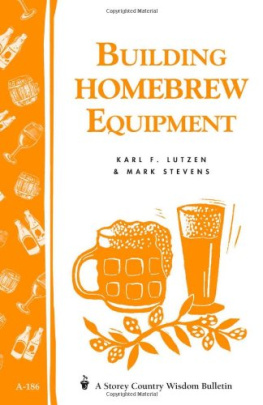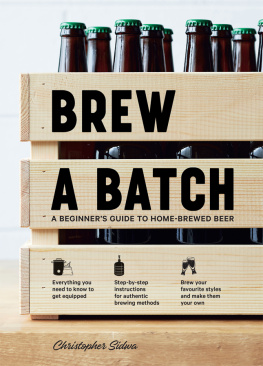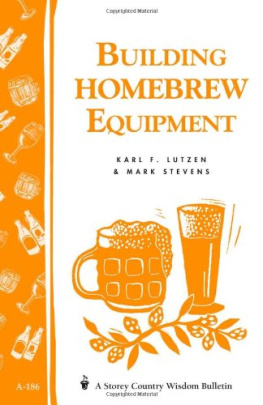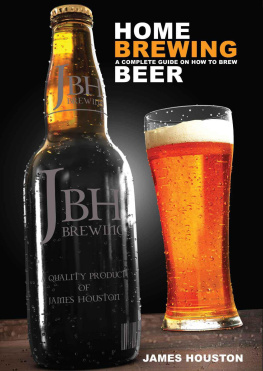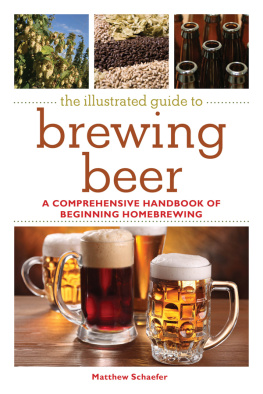BREW WARE
How to Find, Adapt & Build Homebrewing Equipment
Karl F. Lutzen and Mark Stevens
Illustrated by Randy Mosher

The mission of Storey Publishing is to serve our customers by
publishing practical information that encourages
personal independence in harmony with the environment.
Edited by Elizabeth McHale
Cover design by Greg Imhoff
Cover photograph by A. Blake Gardner
Text design by Cynthia McFarland and Meredith Maker
Text production by Susan Bernier and Wanda Harper Joyce
Illustrations by Randy Mosher
Indexed by Northwind Editorial Services
1996 by Karl Lutzen and Mark Stevens
All rights reserved. No part of this book may be reproduced without written permission from the publisher, except by a reviewer who may quote brief passages or reproduce illustrations in a review with appropriate credits; nor may any part of this book be reproduced, stored in a retrieval system, or transmitted in any form or by any means electronic, mechanical, photocopying, recording, or other without written permission from the publisher.
The information in this book is true and complete to the best of our knowledge. All recommendations are made without guarantee on the part of the author or Storey Publishing. The author and publisher disclaim any liability in connection with the use of this information. For additional information, please contact Storey Publishing, 210 MASS MoCA Way, North Adams, MA 01247.
Storey books are available for special premium and promotional uses and for customized editions. For further information, please call 1-800-793-9396.
Printed in the United States by Versa Press
30 29 28 27 26 25 24 23 22 21 20 19
Library of Congress Cataloging-in-Publication Data
Lutzen, Karl F., 1961
Brew ware: how to find, adapt, and build homebrewing equipment/Karl F.
Lutzen and Mark Stevens; illustrated by Randy Mosher
p. cm.
Includes bibliographical references.
ISBN 978-0-88266-926-7 (pb: alk. paper)
I. BrewingAmateurs manuals. I. Stevens, Mark, 1960.
II. Title.
TP570.L88 1996
641.873dc20
96-104
CIP
ACKNOWLEDGMENTS
We wish to thank our many homebrewing friends who shared ideas with us, shared beers with us, and otherwise encouraged us in this project. We would especially like to acknowledge the help, support, and kind advice of Chris Barnhart, Kinney Baughmann, Jim Busch, Bob Dawson, Kirk Fleming, Keith Hooker, Martin Johnson, Larry Koch, Al Korzonas, Jim Mosser, Jack Mowbray, John Palmer, Roy Price, Ruben Rudd, Jack Schmidling, Gene Thomas and many others, to whom we apologize for overlooking. A special toast to Brewers United for Real Potables (BURP).
And finally, we would like to thank Marc Tewey, brewmaster of Brimstone Brewing Company, of Baltimore, Maryland, for taking the time to explain commercial brewing equipment operation to us and allowing us to photograph his brewery.
CONTENTS
FOREWORD
GETTING INTO THE SPIRIT OF HOMEBREWING
The last decade has seen immense growth in the ranks of homebrewers, just as it has seen immense growth in the number of brewpubs and microbreweries what has come to be known as the craft brewing industry. In many ways the two feed on each other: The growth of small breweries inspires hobbyists to brew ever-better beer, and the hobby itself serves as a training ground and experimental laboratory for the craft brewing industry. More than a few brewpubs and microbreweries were started by or are staffed by former homebrewers who had the desire and dedication to learn about and brew great beers.
Indeed, much of the spirit of homebrewing is an experimental one. Its the attitude of tinkerers who are unsatisfied with simply brewing good, clean beers. That very attitude leads brewers to experiment with unusual ingredients or unconventional ways of approaching the brewing process. There are some great brewing ideas out there many of which we undoubtedly have yet to hear about or see in action. The same is true for brewing hardware. In this book, we have tried to give a reasonably comprehensive view of equipment and gadgets used in homebrewing today; however, new gadgets unquestionably will come to market between the time we researched and wrote this book and the time it reaches your bookshelf. And because homebrewers are experimenters and tinkerers, the process will continue. The coming years should see even more great ideas for new equipment and for solving problems as homebrewing continues to grow.
Homebrew supply shops are a vital part of the homebrewing community, providing not only a ready source of ingredients and equipment, but also a ready source of information, tips, and troubleshooting help. The supply shop often serves as a focus point for homebrewers in a local area a place where homebrewers can meet, form clubs, and find out about homebrewing events, such as competitions or beer festivals. A good, knowledgeable, well-stocked local supplier is a valuable resource.
Our intention in writing Brew Ware is to serve the homebrewer and especially the tinkerer those brewers who are not content with the cheapest or easiest route but who seek out alternatives and ever-better gadgets in their quest for great beer.
So if in Brew Ware we show you how to drill a hole in a rubber stopper, it is not because that will be the best approach for everyone, but because that approach best meets the needs of some brewers sometimes. In fact, better solutions (such as the carboy cap) are often available at your local homebrew supply shop, and often at lower cost. Homebrew supply shops can often order the gadgets we describe here, and often at lower cost than you could get by calling the manufacturer directly. But, as we said, our goal in writing this book is to serve the homebrewer, and so we include contact information of the manufacturers so that if you are unable to find a local supplier who carries or is willing to order a gadget that best meets your needs, you can contact the manufacturer to find a supplier who does carry it.
INTRODUCTION
AN OVERVIEW OF BREWING
THE FIVE BASIC STEPS OF BREWING BEER are wort production, boiling, cooling, fermenting, and packaging. Wort production is the creation of a solution of water and the sugars needed for fermentation. For most beginning homebrewers, wort production is simply the blending in a pot of malt extracts and water. For an advanced all-grain brewer, it involves mashing the grains by soaking them in water at an appropriate temperature for an appropriate length of time and then rinsing the grains with water to fully extract the sugars. In the boil, hops are added to the wort and the wort is boiled for at least an hour. The wort is then cooled to a temperature adequate for yeast growth (usually below 80F). To start fermentation, the mixture is shaken vigorously to aerate it, yeast is added, and the beer is allowed to ferment for several days or weeks. During the fermentation period it may be transferred (or racked) to another vessel one or more times in an effort to reduce the amount of sediment and improve the beers clarity. The finished beer is then usually packaged in either bottles or kegs. Its then time for the most important step of all drinking the finished beer!
A complete examination of all these steps would take a book to explain. Fortunately, that book has already been written. Most basic equipment kits sold at homebrew supply stores today will include a basic introduction to brewing. These instructions will explain, in simple terms, what you need to do to brew better beers, have more control over the finished product, and develop a more complete understanding of brewing ingredients, styles, and processes. If you want a book that fully examines the brewing process in a straightforward, technically sound manner, we recommend


